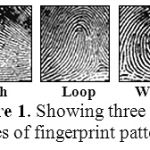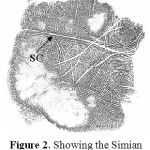Tahir M. Malla*, Parul Srivastava and N. Ganesh
Department of Research, Jawaharlal Nehru Cancer Hospital and Research Centre, Bhopal - 462 001 India.
Abstract
The fingerprint patterns, simian crease, and total ridge count of 21 mentally retarded, Down syndrome (DS) patients were compared with a control group of 21 normal individuals. Patients and controls were unrelated individuals. Quantitative dermatoglyphic parameters comprising of ‘atd’ angle measurement, finger print patterns as whorls, arch, loop, radial loop, ulnar loop and their respective total ridge counts of both hands were studied on both hands together. Significant differences were observed within DS patients as compared with the normal control group. Present studies indicate more intensity and incidence of patterns and TRC in the mentally retarded (Down syndrome) subjects compared to the controls and the values were found to be highly significant (P<0.0001).
Keywords
Down’s syndrome; Dermatoglyphics; ‘atd’ angle
Download this article as:| Copy the following to cite this article: Malla T. M, Srivastava P, Ganesh N.Dermatoglyphic Variations Among Clinically Diagnosed Down’s Syndrome Cases: A Cohort Study.Biomed. Pharmacol. J.2008;1(2) |
| Copy the following to cite this URL: Malla T. M, Srivastava P, Ganesh N.Dermatoglyphic Variations Among Clinically Diagnosed Down’s Syndrome Cases: A Cohort Study.Biomed. Pharmacol. J.2008;1(2). Available from: http://biomedpharmajournal.org/?p=527 |
Introduction
Dermatoglyphic studies are of utmost importance for clinicians for the proper diagnosis of congenital malformations and a variety of genetic disorders especially syndromes. Down’s syndrome is the commonest syndrome having an etiology of trisomy 21 chromosome and an incidence of 1 in every 660 live births1. Long back Cummins (1936) first reported that certain dermatoglyphic configurations occurred more frequently on the digits and palms of patients with Down’s syndrome than in individuals, not so affected2. Since this original observation, the dermal patterns in Down’s syndrome have been studied extensively by many workers (Cummins, 1939; Workman, 1939; Turpin and Caspar-Fonmarty, 1945; Snedeker, 1948; Penrose, 1949; Cummins et al., 1950; Turpin and Lejeune, 1953; Walker, 1957; Hakkinen and Lundell, 1959; Beckman et al, 1962; Holt, 1973).
Cummins (1936, 1939) described the significance of the centrally located axial triradius on the palm of the patients with Down’s syndrome. He also reported significant changes in digital patterns. Later, Penrose (1949) and Walker (1957, 1958) described their significance in the diagnosis of such cases3, 4, 5, 6, 7, 8, 9, 10, 12.
The epidermal ridges are well developed by the 4th month of intrauterine life but the process is completed probably not before the 6th month (Patten 1953). Palmar creases develop during the 2nd and 3rd months of fetal life and are not influenced by the movements of the hand in utero (Wiirth 1937). Once formed, these ridges are permanent, except in size, for life. Genetic or nongenetic factors which produce congenital disorders by influencing fetal development during early intrauterine life may also bring about a significant alteration in dermatoglyphic patterns.
Material and Methods
Selection of cases
Twenty one cases were selected from Maryam Homes, a school for the physically disabled and mentally retarded children located in Bhopal, M. P. India.
Cytogenetic analysis
All the cases were confirmed by cytogenetic investigations as Down’s syndrome cases. Heparinised blood samples were collected and lymphocyte cultures were set for cytogenetic analysis. Karyotyping was carried out by GTG banding technique.
Dermatoglyphic analysis
Finger prints of 21 subjects were taken and studied. Dermatoglyphic analysis was done on the finger and palm prints. Modified Purvis-Smith’ (1969) printing method was used to obtain the dermatoglyphics prints. Printer ink smeared on clean and dry hands was printed on bond paper using a roller. Dermatoglyphic parameters comprising of ‘atd’ angle measurement, finger print patterns as whorls, Arch, Loop, Radial Loop, Ulnar Loop and their respective Total Ridge Counts were studied on both hands. The criteria for selecting the above mentioned parameters are the feasibility of studying them with ease and the effective utilization of time and labor. Student’s t test was performed to analyze the results statistically by GraphPad Prism, version 4 software.
Results
Angular triradius (atd) was measured and compared with the normal values. Out of the 21 cases, 18 were found to have raised ‘atd’ angle and the average value was found to be 51.53. Out of these 18 cases six were found to have ‘atd’ angle in the range of 45-55(33%), four in the range of 55-65 (22%), one in the range of 65-75 (5%), five in the range of 75-85 (28%) and one in the range of 95-105(6%) The intellectual ability was found to be more retarded and the retardation increased with the increase of the ‘atd’ angle.
Present studies indicate more intensity and incidence of patterns and Total Ridge Count in the (mentally retarded) Down syndrome subjects compared to the controls. Mean of the TRC were found to be 103.4 in the controls while 138 in Down syndrome individuals. Total ridge count of right hand in the mentally retarded cases was slightly higher than that of left hand while it was almost the same in controls.
| Control group | Down’s syndrome group | |
| Mean
|
103.4
|
138
|
| p<0.0001, t = 15.05, df = 20
|
||
Table showing the means of the control group and the test group. The means are significantly different p<0.0001.
 |
Figure 1: Showing the types of fingerprint patterns.
|
 |
Figure 2: Showing the Simian crease in one of the DS cases.
|
Discussion and Conclusion
Abnormalities in the growth process, which are liable to distort the alignment of dermal ridges, may result from the action of abnormal genes, chromosomal aberrations, even from poisoning by a drug, or from a viral infection. In some cases the cause remains unknown13, Holt (1973). The characteristic patterns in an individual that deviate from the norm must be caused by the changes occurring before the completion of the fourth fetal month. Since epidermal ridge patterns form early in fetal development and remain unchanged throughout life, unusual dermatoglyphics may indicate gene or chromosomal abnormalities consistent with a disease such as Down’s syndrome.
One of the published reports on dermatoglyphics in DS patients revealed increased ulnar loops and decreased whorl, high incidence of simian crease and decreased total ridge count 14. It could be inferred from the present study that characteristic variations in dermatoglyphic patterns are present in Down’s syndrome cases. The values for TRC of the DS group are raised as compared to the control group and the values are highly significant. (p<0.0001). This study was the first such observation and record in this area and can be used as the basic data which is useful for future research, biometric analysis and multi disciplinary studies.
Acknowledgments
The authors are grateful to Sister Christopher, Principal Maryam Homes, Bhopal for permitting the collection of blood samples of the Down’s syndrome cases.
References
- Roizen NJ, Patterson D. Down’s syndrome. Lancet. 2003 12 April; 361 (9365):1281-9.
- Cummins, H. 1939. Dermatoglyphic stigmata in mongolian idiocy. Rec. 73: 407-415.
- Workman, G. W. 1939. A study of the palmar dermatoglyphics of Mongolian idiots. Thesis, University of Toronto.
- R., and Caspar-Fonmaprty, MME. 1945. Le dactyloscopie des mongoliens. Sent Hop. Paris 21: 341-343.
- Snedeker, D. M. 1948. A study of the palmar dermatoglyphics of mongoloid imbeciles. Biol. 20: 146-155.
- Penrose, L. S. 1949. The Biology of Mental Defect. London: Sidgwick and Jackson.
- Cummins, H., talley, C., and platou, R. V. 1950. Palmar dermatoglyphics in mongolism. Pediatrics 5: 241-248.
- R., and Lejeune, J. 1953. Etude dermatoglyphique des paumes des mongoliens et de leur parents et germains. Sem. Hop. Paris 29: 3954-3967.
- Walker, N. F. 1957. The use of dermal configurations in the diagnosis of mongolism. Pediat. 50: 19-26.
- Hakkinen, I., and Lundell, E. 1959. A dermatoglyphic study of the palms of mongoloids, imbeciles, and normal subjects. Acta Paediat. 48: 379-382.
- Beckman, L., Gustavson, K. H., and Norring, A. 1962. Finger and palm dermal ridge patterns in normal and mongoloid individuals. Acta Genet. (Basel) 12: 20-27.
- Holt, S. B.: The significance of dermatoglyphics in medicine. Clinical Pediatrics, 12: 471- 484 (1973).
- Purvis-Smith, S.G.: Finger and palm printing technique for the children. Medical J. Austria, 2: 189 (1969).
- Mostafa Saadat, Parvin Mehdipour Correlation between IQ and dermatoglyphic indices of Down syndrome patients Dermatology Online Journal, 12 (6): 25 (2006).







